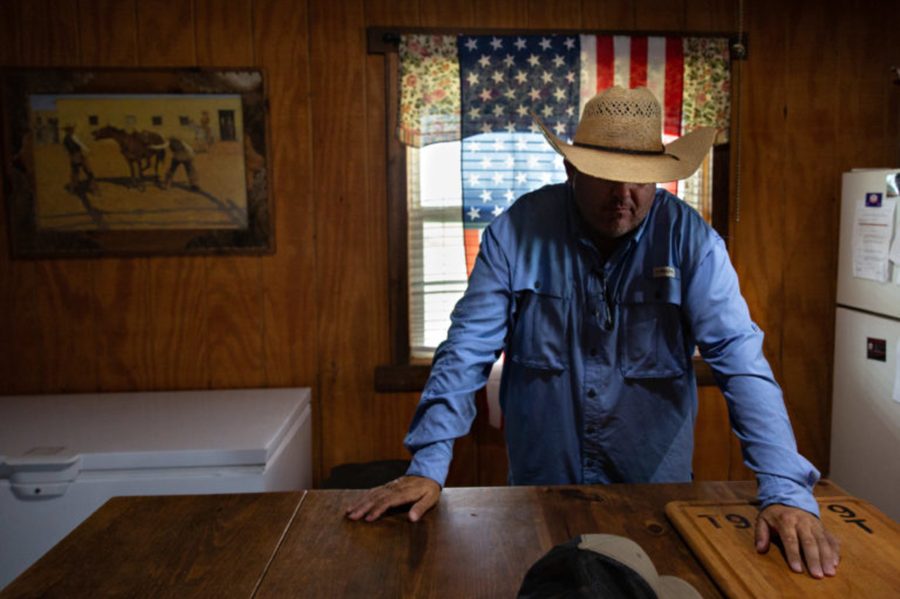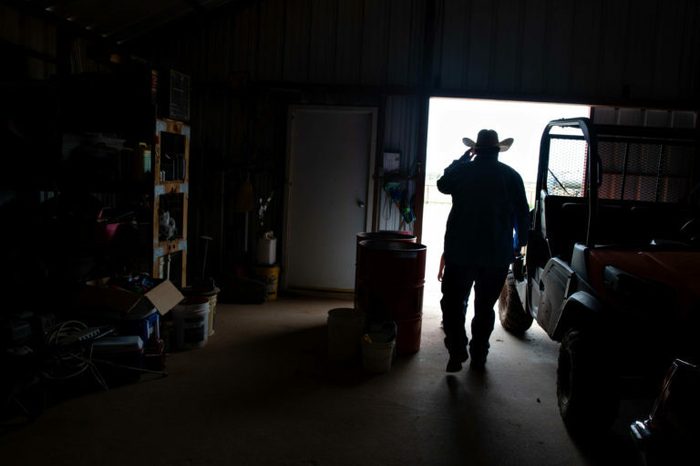While Meatpacking Companies Reap Big Profits, Cattle Ranchers Struggle
Grocery store beef prices are rising. The rancher’s share is falling. And the companies that dominate the highly-concentrated meatpacking industry are making a killing.
Mary Hennigan

Editor’s Note: This story was originally published on The Midwest Center for Investigative Reporting.
Shad Sullivan has stopped paying for cable TV, yearly vacations and trips to movie theaters. He’s contemplated ending his health insurance, even though he needs it for his chronic bone marrow cancer.
A rancher in Olney, Texas, Sullivan, 47, has cut costs as producers like him have felt squeezed by the beef market. While consumers pay high beef prices at the grocery store, very little has trickled down to ranchers — in fact, according to the U.S. Department of Agriculture, the gap between the retail price for beef and the price producers receive is the largest it’s ever been.
In interviews, eight ranchers in seven states agreed their profits have stagnated or even decreased, while the meatpacking companies — which buy the animals for slaughter, then package the meat to be sold at grocery stores — have benefited.
Iowa rancher Eric Nelson said he’s heard people say he’s probably experiencing a windfall based on grocery store prices.
“I tell them, ‘No, we’re not getting any of it,’” the 59-year-old said. “We’re getting less and the consumers are having to pay more.”
Most ranchers agreed the culprit is market concentration. Four companies — Brazil-based JBS, Tyson Foods, Cargill and National Beef — slaughtered about 85% of the cattle in the U.S. in 2018, according to the most recent USDA data. Another school of thought placed the blame on limited capacity — not having enough slaughter plants to process all the beef produced.
Either way, since 2017, the price consumers have paid for beef and veal has increased each year. In 2020, the cost increased by about 10% from 2019, the sixth highest year-to-year increase in four decades.
In turn, the companies’ profits have skyrocketed. From 2010 to 2020, both Tyson and JBS saw an increase in revenue from their cattle operations, 34% and 66% respectively, according to the companies’ annual reports.
But, at the same time, the farmers’ cut has decreased. Between 2010 and 2020, the farmers’ share — beef’s value to the rancher divided by its retail value — decreased by about 9%.
JBS, Cargill and National Beef did not reply to a request for comment. A Tyson Foods spokesperson said to contact the North American Meat Institute, the industry’s lobbying arm. The institute declined to comment and pointed to its testimony from a June 23 U.S. Senate hearing.
“The members of the Meat Institute – and their livestock suppliers – benefit from, and depend on, a fair, transparent and competitive market,” the testimony reads.
The situation has drawn the attention of President Biden, Congress and organizations alike.
Biden signed an executive order July 9 to promote competition in the economy, and one section addressed consolidation in agriculture, specifically in the beef market. The order directs the USDA to consider new rules under the Packers and Stockyards Act that would make it easier for farmers to win claims.
The same day the executive order was signed, Agriculture Secretary Tom Vilsack announced the USDA would spend half a billion dollars to encourage building more meatpacking plants closer to producers, according to the Associated Press.
Bill Bullard, CEO of the organization R-CALF USA, said he is hopeful the developments will eventually alleviate pressures on farmers and ranchers, but he is doubtful that anything will change dramatically in the next year.
“We’ve been trying to get the administrations to do this for two decades,” he said. “It’s a very positive step, but it’s only one of many steps that need to be taken.”
Sullivan agreed.
“(Issues from concentration) did not come about overnight,” he said, “and they’re not going to be fixed overnight.”
One bill introduced in the U.S. Senate would create a unit within the USDA that would investigate anticompetitive practices, and another one would require at least 50% of a meatpacker’s weekly volume be purchased on the open market. Meatpackers having to negotiate prices each week is expected to increase competitive bidding prices – instead of the commonly used formula contracts, which are sometimes made months in advance to ensure supply to the packer and leave the price unknown to the producer.
“Too many people think food comes from supermarkets,” said Sen. Chuck Grassley, R-Iowa, the bills’ cosponsor. “They don’t realize it comes from farms.”
The situation has also spurred lawsuits. R-CALF USA — which only represents ranchers, unlike the more well-known National Cattlemen’s Beef Association whose membership also includes meatpacking companies — sued the four companies in 2019. The case is ongoing, and the National Farmers Union has joined as a plaintiff. (The NCBA did not respond to a request for comment.)
Without large-scale changes, Bullard said, cattle production is at risk of becoming vertically integrated like the poultry and hog industries, meaning companies control the supply chain.
For instance, while poultry producers are technically independent farmers, meatpacking companies provide the chicks and feed. Everything else, such as maintaining the chicken houses, is the producers’ financial responsibility. The arrangement often leads to financial burden, even bankruptcy, according to previous Investigate Midwest reporting.
(Biden’s executive order includes language about “stopping processors from exploiting and underpaying chicken farmers.”)
Bullard worries what the ramifications of the same arrangement in the cattle industry would mean for ranchers.
“As an organization,” he said, “we are fighting aggressively for congressional and administration and judicial reforms that will block the multinational meatpackers from capturing control of our industry away from independent producers.”
‘A very defeating feeling’
On the ranchers’ side, fewer companies bidding for their beef means a smaller sale. With few choices, ranchers often have to settle with the price they’re offered.
Mackenzie Johnston, 32, a fifth-generation cattle producer near Brewster, Nebraska, said she thinks the industry is spiraling out of control.
“It’s just the mere fact that the little guy can’t make it because of the way the markets are,” she said.
Ranching is a demanding business, she said. It’s a year-long operation of moving pasture, fixing fences and fighting the elements to produce the best product. Ranchers also have to update equipment and, if they don’t grow it themselves, buy feed for cattle.
In the “make-or-break deal” of high input costs and low reward, Johnston has started to rely more on her second income after almost 10 years of dedicated ranching, she said.
“It’s a very defeating feeling,” she said.

Johnston works in the cow-calf production sector, which raises cattle for slaughter. Her counterparts in the cattle feeding sector, which brings the cattle to the proper weight for sale, have also faced tough times.
Lee Reichmuth, 41, feeds a herd of about 2,500 to 3,500 at his feedlot in the small town of Lindsay, Nebraska, and he sells to all four major meatpacking companies. But he isn’t sure how much longer he will be able to stay in the industry.
“I’ve got the lowest inventory I’ve had for years and I don’t know when I will step back into the market,” he said. “We can’t continue to buy cattle and produce food for the consumer and lose money doing it.”
‘The packers have all the leverage’
For some, concentration isn’t the market’s major issue. Instead, capacity limitations and black swan events posed a greater threat to the industry, they said.
Montana rancher John Grande, 58, has struggled with profitability. He said he thought risk would be reduced if there were more plants, even if the major companies owned them.
“The prices we don’t like (are) due to the fact that right now the packers have all the leverage because there’s a limited amount of packing capacity chasing a large amount of cattle,” he said.
James Mitchell, a University of Arkansas assistant professor and livestock economist, said he believes the existing companies are bidding as aggressively as they can.
“Right now it’s really just an issue of leverage where we’ve got a lot of animals,” he said. “We’re hitting the upper threshold of what we can process on a daily basis.”
Capacity limits at meatpacking plants cause low demand for cattle, which results in low sales prices for ranchers, he said. Although the market is seen as concentrated, it “has allowed us to enjoy levels of efficiency that we haven’t seen,” he said.
However, efficiency is not the answer Mike Stranz, the National Farmers Union vice president of advocacy, is looking for. Instead, he’s sought resiliency, he said.
He said the food industry has been endangered by a few black swan events in recent years.
First, in 2019, a fire damaged a Tyson’s plant in Holcomb, Kansas. It forced the four-month shut down of the plant, which slaughtered about 5% of the country’s cattle, according to the USDA.
Then, the coronavirus pandemic struck. Plants closed as tens of thousands of workers fell ill and hundreds died. The closures meant packers bought fewer cattle, which likely caused lower bid prices, according to the USDA.
Some ranchers were forced to hold onto their cattle longer than they normally would, putting the cattle at risk of becoming overweight and harder to sell. Prices rose in the grocery store as restaurants closed and people ate at home, driving demand for beef.
“The disruption of meatpacking plants reduced production of meat destined for retail outlets and created a backlog of livestock destined for the closed plants,” according to a USDA report.
The most recent black swan event was the ransomware attack on JBS earlier this year. The attack on the company, which processes nearly one-quarter of U.S. beef, forced plants to shut down for several days, according to Reuters. JBS paid $11 million to reclaim control of its systems.
For ranchers, these events and the market in general have them worried about what the future holds. Sullivan, the Texas rancher, said he’s not sure he wants his children to stay in the industry.
“We have to choose now,” he said. “It’s either us or it’s a whole new system.”
Editor’s Note: The Midwest Center for Investigative Reporting is a nonprofit, online newsroom offering investigative and enterprise coverage of agribusiness, Big Ag and related issues through data analysis, visualizations, in-depth reports and interactive web tools. Visit us online at www.investigatemidwest.org
Mary Hennigan is a recent journalism graduate from the University of Arkansas and an intern at the Midwest Center for Investigative Reporting.




